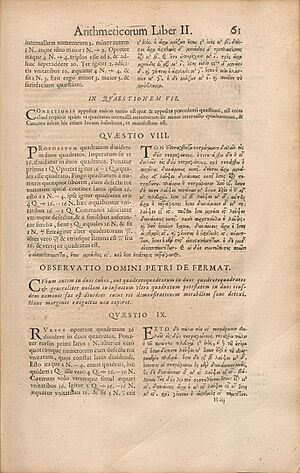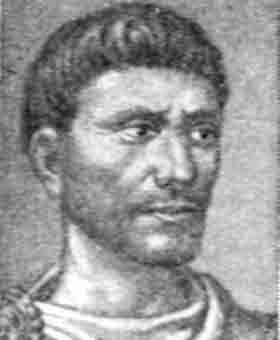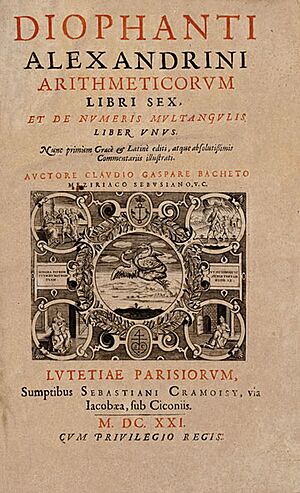Diophantus facts for kids
Diophantus of Alexandria was a Greek mathematician who lived around 200-298 AD. He wrote a famous series of books called Arithmetica. Many of these books are now lost. His writings focused on solving algebraic equations.
Some areas of Number theory are named after him. These include Diophantine equations, Diophantine geometry, and Diophantine approximations.
Diophantus was the first Greek mathematician to accept positive rational numbers as real numbers. This meant he allowed fractions in his equations and solutions. Today, Diophantine equations are algebraic equations with integer numbers. We look for solutions that are also integers.
Contents
Biography
We don't know much about Diophantus's life. He lived in Alexandria, Egypt, during the Roman era. This was likely between 200 and 214 AD and 284 or 298 AD.
Most of what we know about him comes from an old Greek book of puzzles. One puzzle is often called his epitaph, or tombstone message. It tells his life story in a math problem:
- "Here lies Diophantus," the wonder behold.
- Through art algebraic, the stone tells how old:
- God gave him his boyhood one-sixth of his life,
- One twelfth more as youth while whiskers grew rife;
- And then yet one-seventh ere marriage begun;
- In five years there came a bouncing new son.
- Alas, the dear child of master and sage
- After attaining half the measure of his father's life chill fate took him.
- After consoling his fate by the science of numbers for four years, he ended his life.
This puzzle can be written as a math equation. If Diophantus's age is x, the equation is:
- x = x/6 + x/12 + x/7 + 5 + x/2 + 4
If you solve this equation, you find that x equals 84 years. However, we can't be sure if this story is true.
This puzzle was also featured in the video game Professor Layton and Pandora's Box. It was one of the hardest puzzles to solve in the game.
Arithmetica
Arithmetica is Diophantus's most important work. It is a major book on algebra from ancient Greece. It contains many problems that show how to find number solutions for different types of equations.
Originally, Arithmetica had thirteen books. Only six of them have survived. Some people believe that four Arabic books found in 1968 might also be by Diophantus.
History of Arithmetica
Like many old Greek math books, Diophantus's work was forgotten in Western Europe for a long time. However, parts of Arithmetica were copied by scholars in the Byzantine Empire.
In 1463, a German mathematician named Regiomontanus said that no one had translated Diophantus's books from Greek into Latin. He called them "the very flower of the whole of arithmetic."
The first translation of Arithmetica into Latin was done by Rafael Bombelli in 1570. But it was never published. Later, in 1621, a Latin translation by Claude Gaspard Bachet de Méziriac became widely available.
Fermat's Famous Note

The 1621 edition of Arithmetica became very famous because of Pierre de Fermat. He was a French mathematician who owned a copy of the book. He wrote a famous note in the margin of his copy next to a problem. This note became known as "Fermat's Last Theorem":
- “If an integer n is greater than 2, then an + bn = cn has no solutions in non-zero integers a, b, and c. I have a truly marvelous proof of this proposition which this margin is too narrow to contain.”
Fermat's proof was never found. For centuries, mathematicians tried to prove this theorem. Finally, in 1994, Andrew Wiles found a proof after working on it for seven years. Many believe that Fermat did not actually have the proof he claimed.
Fermat was not the only one to write notes in his copy of Diophantus. A Byzantine scholar named John Chortasmenos (1370–1437) once wrote next to the same problem: "Thy soul, Diophantus, be with Satan because of the difficulty of your other theorems and particularly of the present theorem."
Other Works
Diophantus wrote other books besides Arithmetica. However, very few of them have survived.
The Porisms
Diophantus mentioned a lost book called The Porisms. This book was a collection of lemmas, which are like helpful math statements. We know about three lemmas from this lost book because Diophantus referred to them in Arithmetica. One lemma stated that the difference of two rational numbers cubed is equal to the sum of two other rational numbers cubed.
Polygonal Numbers
Diophantus also wrote about polygonal numbers. These are numbers that can be arranged to form regular shapes, like triangles or squares. This topic was very interesting to the ancient Greek mathematician Pythagoras. Some parts of Diophantus's book on polygonal numbers still exist.
Influence
Diophantus's work had a big impact on the history of mathematics. His books greatly influenced the development of algebra in Europe from the 1500s to the 1700s. His work also influenced Arab mathematics.
Diophantus is often called "the father of algebra." This is because he made big contributions to number theory and how we write mathematical symbols. Arithmetica also contains the earliest known use of a simpler way to write math problems. However, some people also give this title to Al-Khwarizmi. Both mathematicians were very important in shaping algebra as we know it today.
Mathematical Notation
Diophantus made important progress in how math was written. He was the first person known to use algebraic symbols. Before him, everyone wrote out equations completely in words.
Diophantus introduced a way to use shorter symbols for common math operations. He also used abbreviations for unknown numbers and their powers.
Even with his advances, Diophantus's notation had limits. He only had symbols for one unknown number. If a problem had more than one unknown, he had to describe them in words, like "first unknown" or "second unknown." He also didn't have a symbol for a general number like n.
For example, where we might write: 12 + 6nn2 − 3
Diophantus would have to write something like: "... a sixfold number increased by twelve, which is divided by the difference by which the square of the number exceeds three."
Algebra still had a long way to go before very complex problems could be written and solved easily.
See also
 In Spanish: Diofanto de Alejandría para niños
In Spanish: Diofanto de Alejandría para niños
- Erdős–Diophantine graph
- Diophantus II.VIII
- Polynomial Diophantine equation



